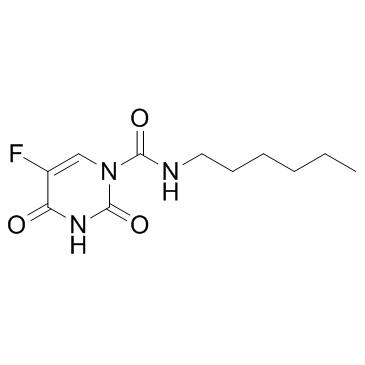Carmofur

Carmofur structure
|
Common Name | Carmofur | ||
|---|---|---|---|---|
| CAS Number | 61422-45-5 | Molecular Weight | 257.261 | |
| Density | 1.3±0.1 g/cm3 | Boiling Point | N/A | |
| Molecular Formula | C11H16FN3O3 | Melting Point | 110-111 | |
| MSDS | Chinese USA | Flash Point | N/A | |
| Symbol |


GHS06, GHS08 |
Signal Word | Danger | |
|
Sphingoid long chain bases prevent lung infection by Pseudomonas aeruginosa.
EMBO Mol. Med. 6(9) , 1205-14, (2014) Cystic fibrosis patients and patients with chronic obstructive pulmonary disease, trauma, burn wound, or patients requiring ventilation are susceptible to severe pulmonary infection by Pseudomonas aeruginosa. Physiological innate defense mechanisms against th... |
|
|
Lysosomal glycosphingolipid catabolism by acid ceramidase: formation of glycosphingoid bases during deficiency of glycosidases.
FEBS Lett. 590 , 716-25, (2016) Glycosphingoid bases are elevated in inherited lysosomal storage disorders with deficient activity of glycosphingolipid catabolizing glycosidases. We investigated the molecular basis of the formation of glucosylsphingosine and globotriaosylsphingosine during ... |
|
|
Efficacy of oral adjuvant therapy after resection of colorectal cancer: 5-year results from three randomized trials.
J. Clin. Oncol. 22(3) , 484-92, (2004) Adjuvant therapy of colorectal cancer with oral fluorinated pyrimidines is attractive because of its ease of administration and good tolerability. The purpose of this meta-analysis is to assess the survival and disease-free survival benefits of treating patie... |
|
|
Discovery of highly potent acid ceramidase inhibitors with in vitro tumor chemosensitizing activity.
Sci. Rep. 3 , 1035, (2013) The expression of acid ceramidase (AC) - a cysteine amidase that hydrolyses the proapoptotic lipid ceramide - is abnormally high in several human tumors, which is suggestive of a role in chemoresistance. Available AC inhibitors lack, however, the potency and ... |
|
|
Raltitrexed treatment promotes systemic inflammatory reaction in patients with colorectal carcinoma.
Br. J. Cancer 87(6) , 591-9, (2002) We studied longitudinally inflammatory reactions and serum C-reactive protein (S-CRP) levels in 52 colorectal cancer patients treated with a median of six 3-weekly cycles of raltitrexed 1.5-3.0 mg m(-2) combined with oral carmofur (1-hexylcarbomoyl-5-fluorour... |
|
|
Subacute leucoencephalopathy induced by carmofur, a 5-fluorouracil derivative.
J. Neurol. 234(6) , 365-70, (1987) Three cases of leucoencephalopathy induced by carmofur (1-hexylcarbamoyl-5-fluorouracil), an antineoplastic derivative of 5-fluorouracil are reported and the literature is reviewed. Initial symptoms were unsteady gait and dementia developing several weeks or ... |
|
|
A multicenter randomized study comparing 5-fluorouracil continuous infusion (ci) plus 1-hexylcarbamoyl-5-fluorouracil and 5-FU ci alone in colorectal cancer.
Oncol. Rep. 14(1) , 129-34, (2005) To verify the effectiveness of oral 1-hexylcarbamoyl-5-fluorouracil (HCFU) in improving the surgical cure rate in advanced colorectal cancer, a multicenter randomized comparative study was conducted. A total of 429 patients who had had curative resection for ... |
|
|
Delivery of hydrophobised 5-fluorouracil derivative to brain tissue through intravenous route using surface modified nanogels.
J. Drug Target. 14(2) , 87-95, (2006) Random copolymeric micelles composed of N-isopropylacrylamide (NIPAAM) and N-vinylpyrrolidone (VP) cross-linked with N,N'-methylenebisacrylamide (MBA) have been used as nanogel carriers to encapsulate N-hexylcarbamoyl-5-fluorouracil (HCFU), a prodrug of 5-FU,... |
|
|
An individual patient data meta-analysis of adjuvant therapy with carmofur in patients with curatively resected colon cancer.
Jpn. J. Clin. Oncol. 35(9) , 536-44, (2005) Oral carmofur, either as a single or in combination with other chemotherapeutic agents, has been used as adjuvant chemotherapy for curatively resected colon cancer patients. Past trials and meta-analyses indicate that it is somewhat effective in extending sur... |
|
|
CEA fluctuation during a single fluorouracil-based chemotherapy cycle for metastatic colorectal cancer.
Anticancer Res. 33(1) , 253-60, (2013) Carcinoembryogenic antigen (CEA) is useful in the evaluation of chemotherapy response of metastatic colorectal cancer (CRC). We studied weekly CEA during one fluorouracil-based chemotherapy cycle, correlated with long-term (8-12 week interval) computed tomogr... |